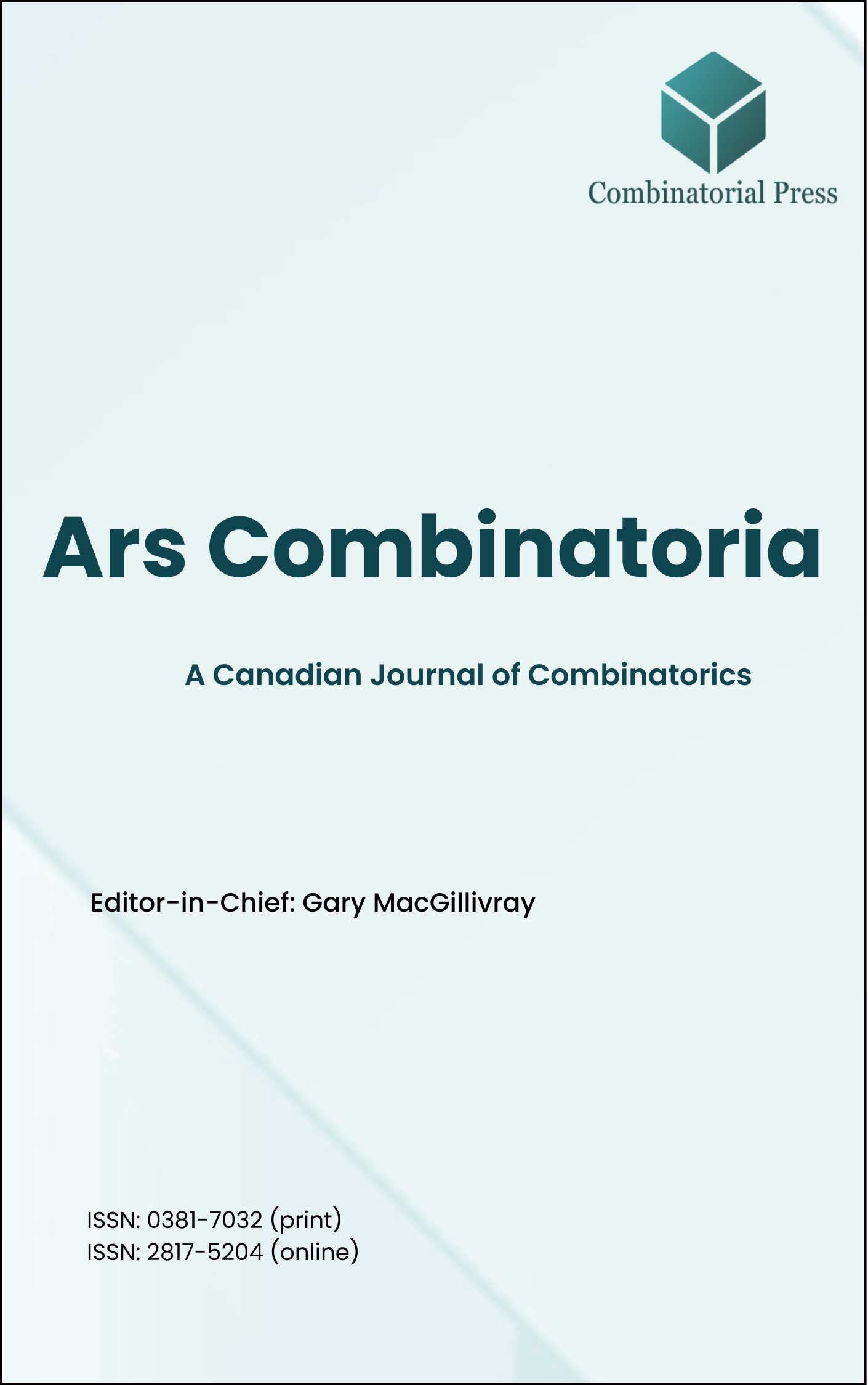
Ars Combinatoria
ISSN 0381-7032 (print), 2817-5204 (online)
Ars Combinatoria is the oldest Canadian Journal of Combinatorics, established in 1976. The journal is dedicated to advancing the field of combinatorial mathematics through the publication of high-quality research papers. From 2024 onward, it publishes four volumes per year in March, June, September and December. Ars Combinatoria has gained recognition and visibility in the academic community and is indexed in renowned databases such as MathSciNet, Zentralblatt, and Scopus. The Scope of the journal includes Graph theory, Design theory, Extremal combinatorics, Enumeration, Algebraic combinatorics, Combinatorial optimization, Ramsey theory, Automorphism groups, Coding theory, Finite geometries, Chemical graph theory but not limited.
Information Menu
- Research article
- Full Text
- Ars Combinatoria
- Volume 046
- Pages: 219-225
- Published: 31/08/1997
The imbalance of edge \((x,y) = | \deg(x) – \deg(y) |\).The sum of all edge imbalances in a graph is called its irregularity.
We determine the maximum irregularity of various classes of graphs.For example, the irregularity of an arbitrary graph with \(n\) vertices is less than \(\frac{4n^3}{27}\), and this bound is tight.
- Research article
- Full Text
- Ars Combinatoria
- Volume 046
- Pages: 211-217
- Published: 31/08/1997
In this paper we show that simplicial graphs, in which every vertex belongs to exactly one simplex, characterize graphs satisfying equality in some graph invariants concerning independence, clique covering, domination or distance.
- Research article
- Full Text
- Ars Combinatoria
- Volume 046
- Pages: 191-209
- Published: 31/08/1997
The plane in the title is investigated from the combinatorial point of view.Its Baer subplanes are classified and their distribution is studied.Properties of the Fano subplanes are shown.Blocking sets of Rédei type are constructed.
Finally, hyperovals and complete \(14\)-arcs are considered and classified.
- Research article
- Full Text
- Ars Combinatoria
- Volume 046
- Pages: 177-190
- Published: 30/04/1997
A graph \(G\) is \(H\)-decomposable if \(G\) can be decomposed into graphs, each of which is isomorphic to \(H\).
A graph \(G\) without isolated vertices is a least common multiple of two graphs \(G_1\) and \(G_2\) if \(G\) is a graph of minimum size such that \(G\) is both \(G_1\)-decomposable and \(G_2\)-decomposable.
It is shown that two graphs can have an arbitrarily large number of least common multiples.
All graphs \(G\) for which \(G\) and \(P_3\) (and \(G\) and \(2K_2\)) have a unique least common multiple are characterized.
It is also shown that two stars \(K_{1,r}\) and \(K_{1,s}\) have a unique least common multiple if and only if \(r\) and \(s\) are not relatively prime.
- Research article
- Full Text
- Ars Combinatoria
- Volume 046
- Pages: 161-176
- Published: 31/08/1997
A Restricted Resolvable Design \(R_rRP(p, k)\) is a resolvable design on \(p\) points with block sizes \(r\) and \(r+1\) in which each point appears \(\alpha\) times. An \(RRP\) is called uniform if all resolution classes consist of the blocks of the same size.
We show that a uniform \(R_3RP(p,\frac{p}{2} -2)\) exists for all \(p \equiv 12 \mod 24, p \neq 12\) except possibly when \(p = 84\) or \(156\).
We also show that if \(g \equiv 3 \mod 6, g \notin \{3, 21, 39\}\) and \(p = 4g \mod 8g\) then there exists an \(R_3RP(p, \frac{p}{2}-(r+1))\) for all
- \(r \leq \frac{p-4g}{8g}\) if \(\frac{p}{4g}\) is a prime power congruent to \(1 \mod 6\);
- \(r \leq \frac{p}{4gq}\) where \(q\) is the smallest proper factor of \(\frac{p}{4g}\) if \(\frac{p}{4g}\) is composite and there exists an \(RT(9, \frac{p}{4gp})\).
- Research article
- Full Text
- Ars Combinatoria
- Volume 046
- Pages: 153-160
- Published: 31/08/1997
The core of a graph was defined by Morgan and Slater [MS80] as a path in the graph minimizing the sum of the distance of all vertices of the graph from the path. A linear algorithm to find the core of a tree has been given in [MS80]. For the general graph the problem can be shown to be NP-hard using a reduction from the Hamiltonian path problem.
A graph with no chordless cycle of length exceeding three is called a chordal graph. Every chordal graph is the intersection graph of a family of subtrees of a tree. The intersection graph of a family of undirected paths of a tree is called a UV graph. The intersection graph of an edge disjoint family of paths of a tree is called a CV graph [AAPX91]. We have characterised that the CV graphs are nothing but block graphs. CV graphs form a proper subclass of UV graphs which in turn form a proper subclass of chordal graphs.
In this paper, we present an \( {O}(ne)\) algorithm to find the core of a CV graph, where \(n\) is the number of vertices and \(e\) is the number of edges.
- Research article
- Full Text
- Ars Combinatoria
- Volume 046
- Pages: 145-151
- Published: 31/08/1997
The worst-case time-complexity of Read’s edge-addition/contraction algorithm for computing the chromatic polynomial of an \(n\)-vertex graph is shown to be \({O}(n^2B(n))\), where \(B(n)\) is the \(n\)th Bell number, which grows faster than \(c^n\) for any \(c\) but slower than \(n!\). The factor \(n^2\) can be reduced to \(n\), and the space-complexity from \({O}(n^3)\) to \({O}(n^2)\), by storing in arrays the information needed to reverse each transformation made on the graph.
- Research article
- Full Text
- Ars Combinatoria
- Volume 046
- Pages: 133-144
- Published: 31/08/1997
This paper provides an expository account, from a design-theoretic point of view, of the important result of Ryser that covering of the complete graph \(K_v\) a total of \(\lambda\) times by \(v\) complete subgraphs can only be done in a very limited number of ways.
- Research article
- Full Text
- Ars Combinatoria
- Volume 046
- Pages: 129-132
- Published: 31/08/1997
We give an exponential lower bound for the maximum number of chords in a cycle of a graph \(G\) in terms of the minimum degree of \(G\) and the girth of \(G\). We also give regular graphs having no small cycles where the maximum number of chords possible in any cycle of the graph is approximately the fourth power of our lower bound. An immediate consequence is a recent result of Ali and Staton.
- Research article
- Full Text
- Ars Combinatoria
- Volume 046
- Pages: 119-127
- Published: 31/08/1997
The edge-integrity of a graph \(G\) is given by the minimum of \(|S|+m(G-S)\) taken over all \(S \subseteq E(G)\), where \(m(G-S)\) denotes the maximum order of a component of \(G-S\). An honest graph is one with maximum edge-integrity (viz. its order). In this paper, lower and upper bounds on the edge-integrity of a graph with given order and diameter are investigated. For example, it is shown that the diameter of an honest graph on \(n\) vertices is at most \(\sqrt{8n}-3\), and this is sharp. Also, a lower bound for the edge-integrity of a graph in terms of its eigenvalues is established. This is used to show that for \(d\) sufficiently large, almost all \(d\)-regular graphs are honest.





